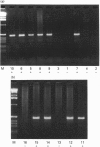Abstract
In humans, glutathione-dependent conjugation of halomethanes is polymorphic, with 60% of the population classed as conjugators and 40% as non-conjugators. We report the characterization of the genetic polymorphism causing the phenotypic difference. We have isolated a cDNA that encodes a human class Theta GST (GSTT1) and which shares 82% sequence identity with rat class Theta GST5-5. From PCR and Southern blot analyses, it is shown that the GSTT1 gene is absent from 38% of the population. The presence or absence of the GSTT1 gene is coincident with the conjugator (GSST1+) and non-conjugator (GSTT1-) phenotypes respectively. The GSTT1+ phenotype can catalyse the glutathione conjugation of dichloromethane, a metabolic pathway which has been shown to be mutagenic in Salmonella typhimurium mutagenicity tester strains and is believed to be responsible for carcinogenicity of dichloromethane in the mouse. In humans, the enzyme is found in the erythrocyte and this may act as a detoxification sink. Characterization of the GSTT1 polymorphism will thus enable a more accurate assessment of human health risk from synthetic halomethanes and other industrial chemicals.
Full text
PDF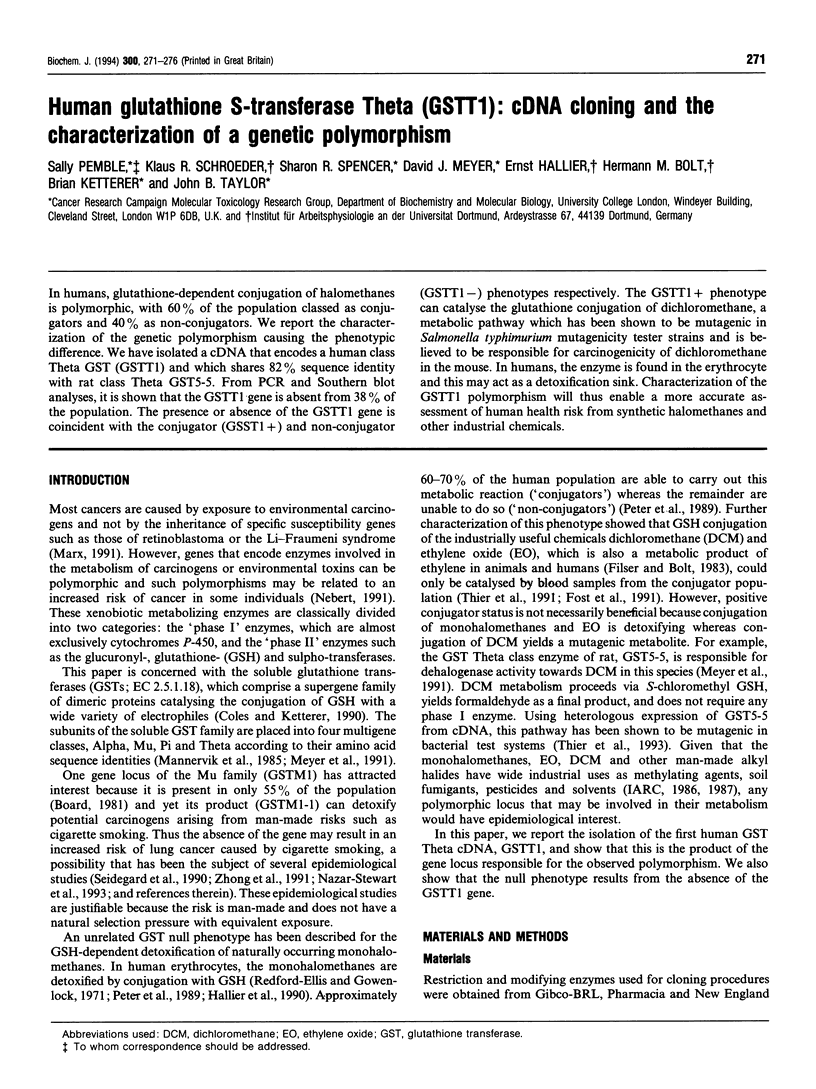
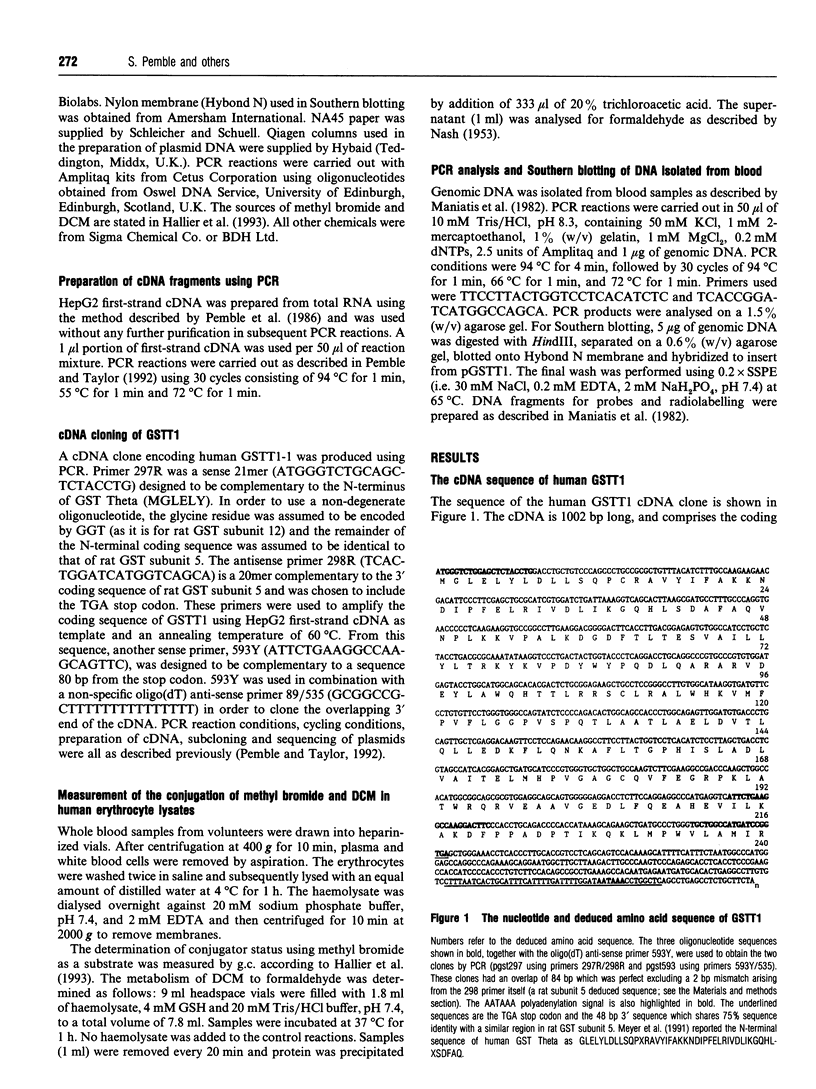

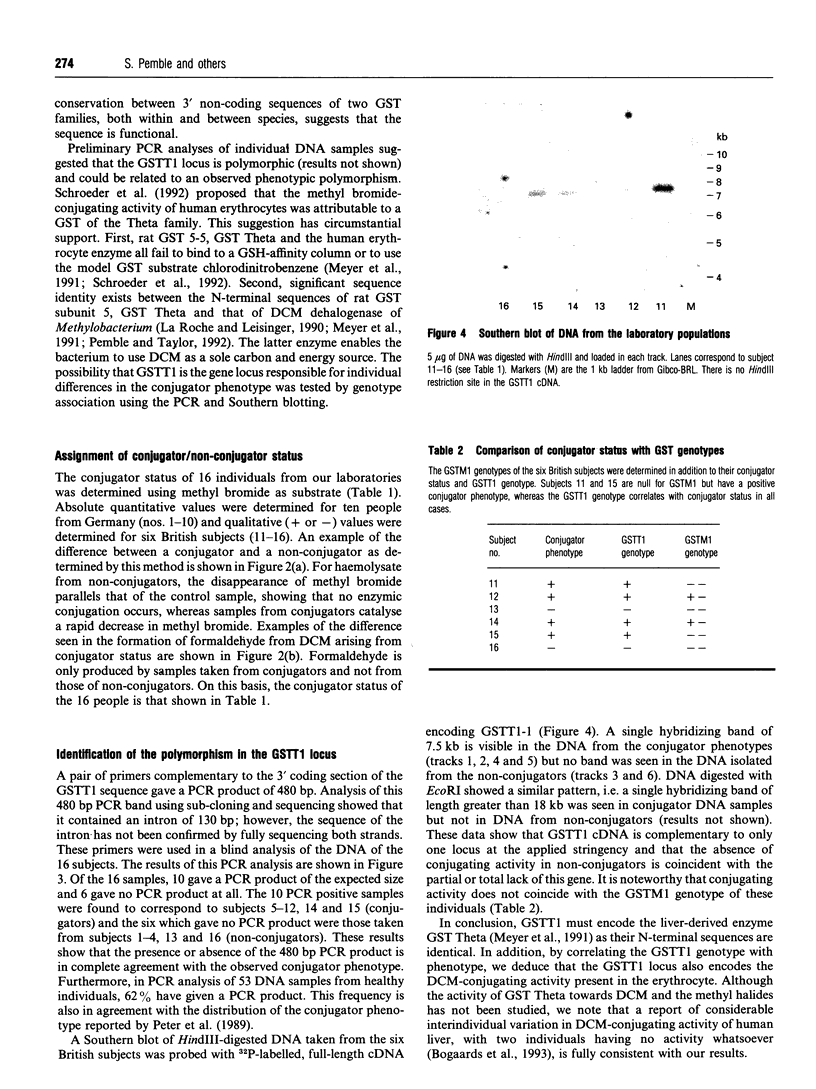
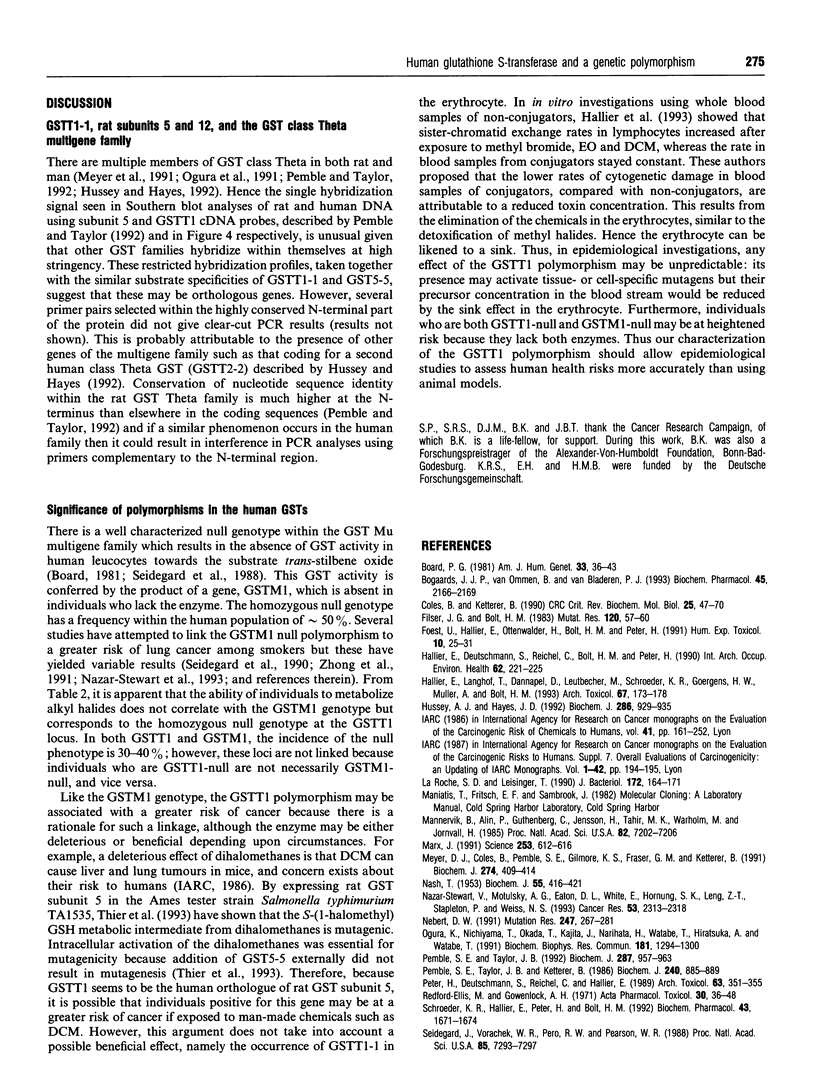

Images in this article
Selected References
These references are in PubMed. This may not be the complete list of references from this article.
- Board P. G. Biochemical genetics of glutathione-S-transferase in man. Am J Hum Genet. 1981 Jan;33(1):36–43. [PMC free article] [PubMed] [Google Scholar]
- Bogaards J. J., van Ommen B., van Bladeren P. J. Interindividual differences in the in vitro conjugation of methylene chloride with glutathione by cytosolic glutathione S-transferase in 22 human liver samples. Biochem Pharmacol. 1993 May 25;45(10):2166–2169. doi: 10.1016/0006-2952(93)90033-s. [DOI] [PubMed] [Google Scholar]
- Coles B., Ketterer B. The role of glutathione and glutathione transferases in chemical carcinogenesis. Crit Rev Biochem Mol Biol. 1990;25(1):47–70. doi: 10.3109/10409239009090605. [DOI] [PubMed] [Google Scholar]
- Filser J. G., Bolt H. M. Exhalation of ethylene oxide by rats on exposure to ethylene. Mutat Res. 1983 Apr;120(1):57–60. doi: 10.1016/0165-7992(83)90074-x. [DOI] [PubMed] [Google Scholar]
- Föst U., Hallier E., Ottenwälder H., Bolt H. M., Peter H. Distribution of ethylene oxide in human blood and its implications for biomonitoring. Hum Exp Toxicol. 1991 Jan;10(1):25–31. doi: 10.1177/096032719101000105. [DOI] [PubMed] [Google Scholar]
- Hallier E., Deutschmann S., Reichel C., Bolt H. M., Peter H. A comparative investigation of the metabolism of methyl bromide and methyl iodide in human erythrocytes. Int Arch Occup Environ Health. 1990;62(3):221–225. doi: 10.1007/BF00379437. [DOI] [PubMed] [Google Scholar]
- Hallier E., Langhof T., Dannappel D., Leutbecher M., Schröder K., Goergens H. W., Müller A., Bolt H. M. Polymorphism of glutathione conjugation of methyl bromide, ethylene oxide and dichloromethane in human blood: influence on the induction of sister chromatid exchanges (SCE) in lymphocytes. Arch Toxicol. 1993;67(3):173–178. doi: 10.1007/BF01973304. [DOI] [PubMed] [Google Scholar]
- Hussey A. J., Hayes J. D. Characterization of a human class-Theta glutathione S-transferase with activity towards 1-menaphthyl sulphate. Biochem J. 1992 Sep 15;286(Pt 3):929–935. doi: 10.1042/bj2860929. [DOI] [PMC free article] [PubMed] [Google Scholar]
- La Roche S. D., Leisinger T. Sequence analysis and expression of the bacterial dichloromethane dehalogenase structural gene, a member of the glutathione S-transferase supergene family. J Bacteriol. 1990 Jan;172(1):164–171. doi: 10.1128/jb.172.1.164-171.1990. [DOI] [PMC free article] [PubMed] [Google Scholar]
- Mannervik B., Alin P., Guthenberg C., Jensson H., Tahir M. K., Warholm M., Jörnvall H. Identification of three classes of cytosolic glutathione transferase common to several mammalian species: correlation between structural data and enzymatic properties. Proc Natl Acad Sci U S A. 1985 Nov;82(21):7202–7206. doi: 10.1073/pnas.82.21.7202. [DOI] [PMC free article] [PubMed] [Google Scholar]
- Marx J. Zeroing in on individual cancer risk. Science. 1991 Aug 9;253(5020):612–616. doi: 10.1126/science.1651561. [DOI] [PubMed] [Google Scholar]
- Meyer D. J., Coles B., Pemble S. E., Gilmore K. S., Fraser G. M., Ketterer B. Theta, a new class of glutathione transferases purified from rat and man. Biochem J. 1991 Mar 1;274(Pt 2):409–414. doi: 10.1042/bj2740409. [DOI] [PMC free article] [PubMed] [Google Scholar]
- NASH T. The colorimetric estimation of formaldehyde by means of the Hantzsch reaction. Biochem J. 1953 Oct;55(3):416–421. doi: 10.1042/bj0550416. [DOI] [PMC free article] [PubMed] [Google Scholar]
- Nazar-Stewart V., Motulsky A. G., Eaton D. L., White E., Hornung S. K., Leng Z. T., Stapleton P., Weiss N. S. The glutathione S-transferase mu polymorphism as a marker for susceptibility to lung carcinoma. Cancer Res. 1993 May 15;53(10 Suppl):2313–2318. [PubMed] [Google Scholar]
- Nebert D. W. Role of genetics and drug metabolism in human cancer risk. Mutat Res. 1991 Apr;247(2):267–281. doi: 10.1016/0027-5107(91)90022-g. [DOI] [PubMed] [Google Scholar]
- Ogura K., Nishiyama T., Okada T., Kajital J., Narihata H., Watabe T., Hiratsuka A., Watabe T. Molecular cloning and amino acid sequencing of rat liver class theta glutathione S-transferase Yrs-Yrs inactivating reactive sulfate esters of carcinogenic arylmethanols. Biochem Biophys Res Commun. 1991 Dec 31;181(3):1294–1300. doi: 10.1016/0006-291x(91)92079-y. [DOI] [PubMed] [Google Scholar]
- Pemble S. E., Taylor J. B. An evolutionary perspective on glutathione transferases inferred from class-theta glutathione transferase cDNA sequences. Biochem J. 1992 Nov 1;287(Pt 3):957–963. doi: 10.1042/bj2870957. [DOI] [PMC free article] [PubMed] [Google Scholar]
- Pemble S. E., Taylor J. B., Ketterer B. Tissue distribution of rat glutathione transferase subunit 7, a hepatoma marker. Biochem J. 1986 Dec 15;240(3):885–889. doi: 10.1042/bj2400885. [DOI] [PMC free article] [PubMed] [Google Scholar]
- Peter H., Deutschmann S., Reichel C., Hallier E. Metabolism of methyl chloride by human erythrocytes. Arch Toxicol. 1989;63(5):351–355. doi: 10.1007/BF00303122. [DOI] [PubMed] [Google Scholar]
- Redford-Ellis M., Gowenlock A. H. Studies on the reaction of chloromethane with human blood. Acta Pharmacol Toxicol (Copenh) 1971;30(1):36–48. doi: 10.1111/j.1600-0773.1971.tb00632.x. [DOI] [PubMed] [Google Scholar]
- Schröder K. R., Hallier E., Peter H., Bolt H. M. Dissociation of a new glutathione S-transferase activity in human erythrocytes. Biochem Pharmacol. 1992 Apr 15;43(8):1671–1674. doi: 10.1016/0006-2952(92)90695-f. [DOI] [PubMed] [Google Scholar]
- Seidegård J., Pero R. W., Markowitz M. M., Roush G., Miller D. G., Beattie E. J. Isoenzyme(s) of glutathione transferase (class Mu) as a marker for the susceptibility to lung cancer: a follow up study. Carcinogenesis. 1990 Jan;11(1):33–36. doi: 10.1093/carcin/11.1.33. [DOI] [PubMed] [Google Scholar]
- Seidegård J., Vorachek W. R., Pero R. W., Pearson W. R. Hereditary differences in the expression of the human glutathione transferase active on trans-stilbene oxide are due to a gene deletion. Proc Natl Acad Sci U S A. 1988 Oct;85(19):7293–7297. doi: 10.1073/pnas.85.19.7293. [DOI] [PMC free article] [PubMed] [Google Scholar]
- Thier R., Foest U., Deutschmann S., Schroeder K. R., Westphal G., Hallier E., Peter H. Distribution of methylene chloride in human blood. Arch Toxicol Suppl. 1991;14:254–258. doi: 10.1007/978-3-642-74936-0_53. [DOI] [PubMed] [Google Scholar]
- Thier R., Taylor J. B., Pemble S. E., Humphreys W. G., Persmark M., Ketterer B., Guengerich F. P. Expression of mammalian glutathione S-transferase 5-5 in Salmonella typhimurium TA1535 leads to base-pair mutations upon exposure to dihalomethanes. Proc Natl Acad Sci U S A. 1993 Sep 15;90(18):8576–8580. doi: 10.1073/pnas.90.18.8576. [DOI] [PMC free article] [PubMed] [Google Scholar]
- Zhong S., Howie A. F., Ketterer B., Taylor J., Hayes J. D., Beckett G. J., Wathen C. G., Wolf C. R., Spurr N. K. Glutathione S-transferase mu locus: use of genotyping and phenotyping assays to assess association with lung cancer susceptibility. Carcinogenesis. 1991 Sep;12(9):1533–1537. doi: 10.1093/carcin/12.9.1533. [DOI] [PubMed] [Google Scholar]



